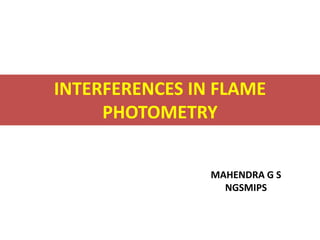
Fe spectroscopy inteference
- 1. INTERFERENCES IN FLAME PHOTOMETRY MAHENDRA G S NGSMIPS
- 2. Types of Interferences 1. Spectral interference 2. Background emission 3. Chemical interferences 4. Cation interference 5. Anion interference 6. Oxide formation interference 7. Interference due to foreign elements 8. Interference due to salts and acids 9. Matrix effects 10. Interference due to molecular absorption
- 3. Spectral Interference It is encountered while isolating the desired radiant energy. The line of emission of the element to be determined and those due to interfering substances are of similar wavelength. For eg., iron line at 324.728 nm overlaps the copper line at 324.754 nm and other iron line at 285.213 nm overlaps the magnesium line at 285.212 nm. By using calibration curves the effect of interfering element is removed. It is also removed by improving the resolution of the instrument.
- 4. Background emission Interference may arise from the emission band spectra produced by molecules or molecular fragments present in the flame gases. For eg., band spectra due to hydroxyl and cyanogen radicals arise in many flames. Background effects can also be caused by light scatter. It is eliminated by using blank solution.
- 5. Chemical interferences The production of ground state gaseous atoms which is the basis of flame spectroscopy may be inhibited by two main forms of chemical interferences. a) Stable compound formation b) Ionization a) Stable compound formation: This leads to incomplete dissociation of the substance to be analyzed when placed in the flame or fail to dissociate into the constituent atoms. For example, the determination of calcium in the presence of sulphate or phosphate and formation of stable refractory oxides of aluminium, titanium and vanadium.
- 6. Chemical interferences Chemical interferences can be overcome by one of the following ways: I. Increase in the flame temperature: often leads to the formation of free gaseous atoms. For eg., aluminium oxide is more readily dissociated in an acetylene-nitrous oxide flame than it is in an acetylene-air flame.
- 7. Chemical interferences II. By the use of releasing agents: For eg., determination of calcium in presence of phosphate, the addition of an excess of strontium chloride to the test solution will lead to the formation of strontium phosphate. Calcium can then be determined in an acetylene-air flame without any interference due to phosphate. III. Extraction of an analyte or of the interfering element is an obvious method of overcoming the effect of interferences.
- 8. Cation interference It is observed with high temperature flame that the intensity of a line for one cation is enhanced due to the presence of another. This enhancement results from the decrease in ionization of the cation being studied due to the presence of second cation. For eg., the doubling of line intensity of rubidium due to the presence of potassium ion. The addition of radiation buffer to both the sample and the standard minimizes cation inteferences. The buffer consists of high concentration of potentially interfering ion.
- 9. Anion interference The presence of certain anions in a solution may affect the intensity of radiation emitted by an element and results in serious analytical error. Anions such as sulphate, phosphate, oxalate, and aluminate may affect the intensity of radiation emitted by an element. For eg., a concentration of barium sulphate produces low emission intensity than the same concentration of barium chloride. The anion interference is minimized by using radiation buffer or releasing agents.
- 10. Oxide formation interference It arises due to the formation of stable oxide with free metal atoms if oxygen is present in the flame. Thus, the emission intensity is lowered because a large percentage of free metal atoms have been removed from the flame. It is minimized by using very high temperature flames to dissociate the oxides producing free atoms for excitation or using oxygen deficient environment to produce excited atoms.
- 11. Interference due to foreign elements This interference depends upon the quality of monochromator, source temperature and the concentration ratio between the contaminant and the element sought. Thus the use of filter will minimize this interference.
- 12. Interference due to Salts & Acids Large amount of salts and acids lower the metallic emission intensity. Use of a releasing agent or protective chelating agents circumvents this type of interference.
- 13. Matrix effects Matrix effects are physical factors which influence the amount of sample reaching the flame and are related to viscosity, surface tension, density, vapor pressure and volatility of the solvent used to prepare the test solution. If a series of standards is to be compared with a test solution, it is essential that the same solvent should be used for each and the solutions should not differ widely in their bulk composition.
- 14. Interference due to molecular absorption In an acetylene-air flame a high concentration of sodium chloride will absorb radiation at wavelengths 213.9nm, which is the wavelength of the major zinc resonance line. Hence sodium chloride would interfere in the determination of zinc under these conditions. It can be avoided by choosing a different resonance line or by using a hotter flame resulting in an increase in the operating temperature, thus leading to dissociation of the interfering molecules.
- 15. Conclusion: • Flame photometry is a simple rapid method for the routine determination of elements that are easily excited. • Using equipment’s with high optical resolution other metallic elements may also be determined